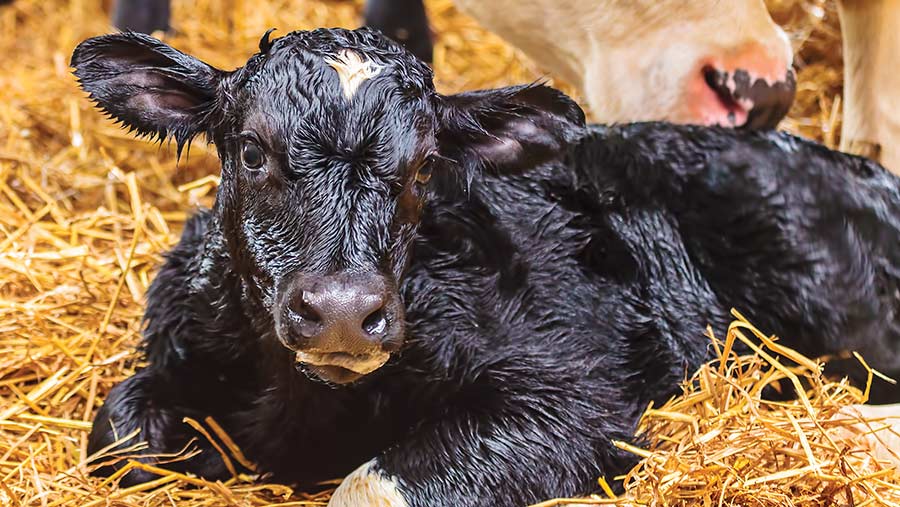Advice on grazing far-off-dry cows for correct dietary needs
 © Martin Bergsma/Adobe Stock
© Martin Bergsma/Adobe Stock Far-off dry cows at grass could be getting too much energy if summer rainfall has produced lush regrowth.
Cows either need to graze stemmy pasture, below 10MJ of metabolisable energy (ME)/kg of dry matter (DM), or stocking rates need to tighten.
See also: Expert advice for grazing cows
This advice comes from nutritionist Charlie Davies of Kelly Farm Consulting.
Although many dairy farmers still like to turn out their dry cows – for welfare reasons, a lack of shed space, or to save labour – Charlie says it is important to consider the type of grazing on offer.
This is because the early dry period is crucial for resetting the high-yielding cow’s insulin response. What is needed is a low-starch, high-forage diet.
He explains that cows on a prolonged high-starch (16-20%) or high-sugar (3-8%) diet throughout lactation have high insulin levels.
Over time, the body’s cells begin to accept this as normal.
As with humans, the body’s responsiveness to insulin falls and sugar levels remain high, leading to type 2 diabetes, where cells cannot absorb glucose to use for energy.
“Three to four weeks with no sugar or starch resets the norm. If you don’t reset the insulin response, you can end up with sluggish cows post calving,” he says.
Rumen fill
“Early dry cow periods have a low energy requirement, of around 100MJ a cow a day for a Holstein type, for maintenance and no milk.
But it requires good levels of rumen fill [at this stage] to ensure [sufficient] intakes post-calving.
High-quality grazing can be too energy dense for cows during the early dry period. Indoors, these cows would be on third- or fourth-cut silage.”
To achieve the correct balance of rumen fill and energy, new leys should be avoided.
Permanent pasture, stemmy grass or silage leys that have gone to seed are preferable.
“Some people have a designated dry-cow paddock which is small, with easy access and a ring feeder – and everyone walks past it so they can check the cows.
“It’s a field that usually gets no slurry or fertiliser and, where grass looks burnt-off and bare, there is no worry.
“But when there is regrowth, you need to restrict access so cows aren’t grazing too much grass and, therefore, energy.
“Some nice regrowth high in sugar will defeat the object. Stocking rates should be 247 cows a ha a day [100 cows an acre a day] in a two-week period.”
Supplement with straw
Ideally, far-off dry cows in bare paddocks should be supplemented with forage of low nutritional quality, such as late-cut silage or straw, with some sort of mineral supplement via lick blocks or dry cow concentrate, says Charlie.
“Keep an eye on rumen fills: don’t turn your back on them [dry cows] for four weeks. It might be the lowest maintenance period, but it is important to get them set up for the next lactation.”
He also advises watching and planning for extreme weather patterns, so, for example, cows can be brought into shade to reduce heat stress if needed.
Using the temperature humidity index (see box), cows need shade once temperatures reach 30C, although they may display some stress at 26C.
“There are long-term consequences from heat stress. For instance, last year, we saw cystic cows [those that do not ovulate normally] into October, due to their eggs being made in the heatwave when they calved.
“An Indian summer later in the year can produce similar effects.”
Once cows get to the late dry period, three to four weeks pre-calving, they should switch to the “Goldilocks” diet.
“It needs to meet energy requirements – not too much, not too little,” says Charlie.
At this point, he says, mineral balance is becoming critical for early lactation, and negative energy balance must be avoided, so close-up cows are best housed for ration control and consistency.
Managing heat stress in dairy cows
For more information on managing heat stress and temperature humidity index, visit the National Animal Disease Information Service (Nadis) website.
